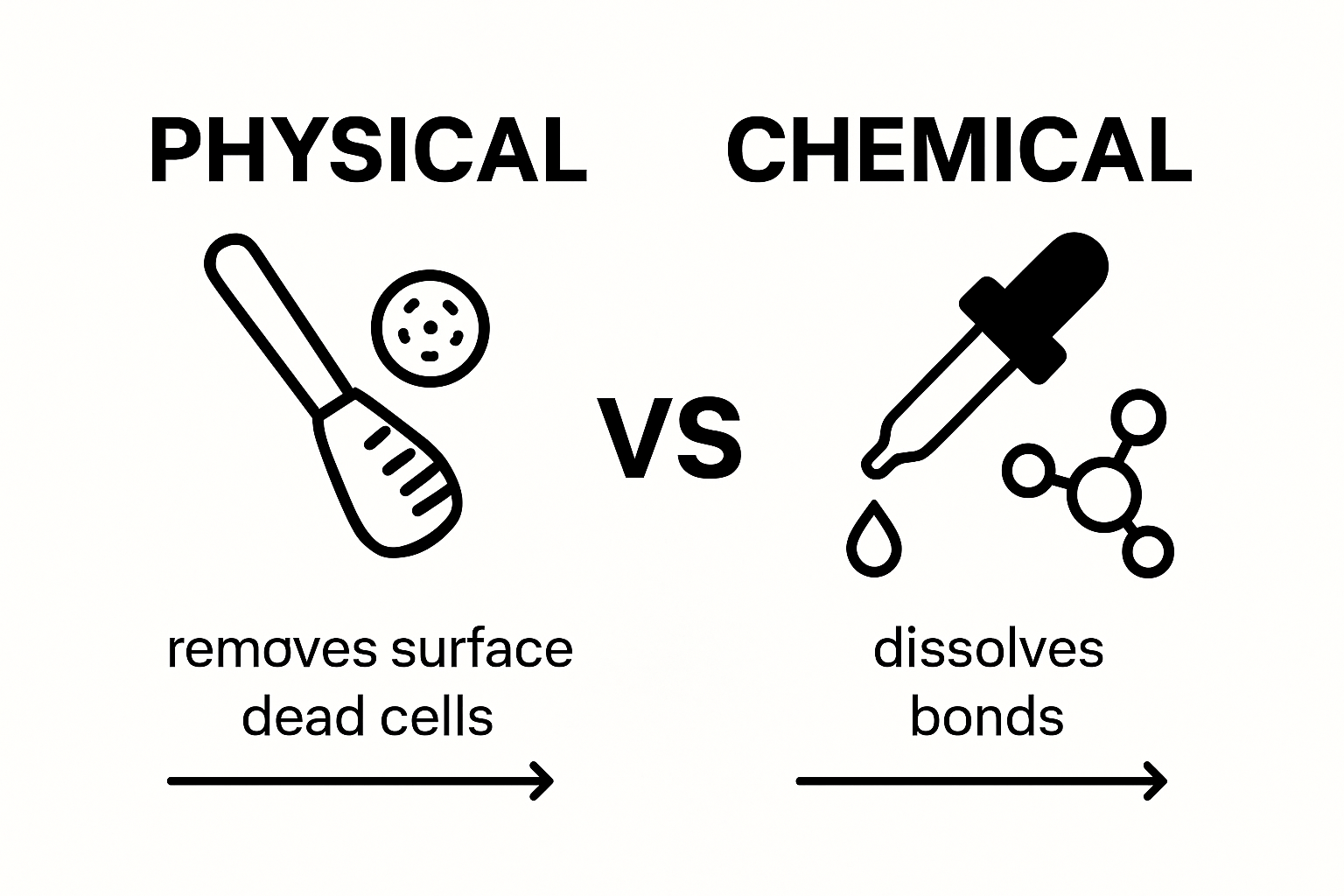Scrubbing away dry and dull skin sounds simple and even a little satisfying. Yet most people have no idea that your skin naturally sheds close to 500 million cells every single day, piling up on your face and body. That pile-up is what really stands between you and fresh-looking skin. Exfoliants are not just another product in the cabinet. The right one can completely change the way your skin looks and feels.
Table of Contents
- What Are Exfoliants And Their Purpose?
- Types Of Exfoliants: Physical Vs. Chemical Explained
- Why Exfoliation Matters For Skin Health
- How Different Exfoliants Work On The Skin
- Choosing The Right Exfoliant For Your Skin Type
Quick Summary
| Takeaway | Explanation |
|---|---|
| Exfoliation enhances skin texture. | Regularly removing dead skin cells improves overall skin appearance and promotes cell renewal. |
| Choose the right exfoliant for your skin type. | Matching exfoliation techniques with skin characteristics prevents irritation and enhances effectiveness. |
| Mechanical and chemical methods differ. | Mechanical exfoliants physically scrub skin, while chemical exfoliants dissolve dead skin cells at a molecular level. |
| Regular exfoliation prevents skin issues. | Consistent use helps prevent acne, improves absorption of skincare products, and promotes a healthy glow. |
| Consult a professional for personalized advice. | A skincare expert can help determine the best exfoliation method tailored to individual skin needs. |
What Are Exfoliants and Their Purpose?
Exfoliants are specialized skincare treatments designed to remove dead skin cells from the surface of the skin, promoting cellular renewal and improving overall skin texture and appearance. These remarkable products work by mechanically or chemically breaking down and eliminating the outermost layer of dead skin cells, revealing fresher, more radiant skin underneath.
Types of Exfoliation
There are two primary methods of exfoliation: mechanical and chemical. Mechanical exfoliation involves physically scrubbing away dead skin cells using tools or textured substances like scrubs, brushes, or loofahs. Chemical exfoliation utilizes specific acids or enzymes that dissolve the bonds between dead skin cells, allowing them to be easily removed.
According to research from the Cleveland Clinic, exfoliation procedures can significantly improve skin texture by:
- Removing accumulated dead skin cells
- Unclogging pores
- Stimulating cellular regeneration
- Enhancing skin’s natural luminosity
Benefits of Regular Exfoliation
Regular exfoliation offers multiple skin health benefits beyond surface-level appearance. By removing the barrier of dead skin cells, exfoliants enable better absorption of skincare products, improve circulation, and can help address specific skin concerns like:
- Reducing visible signs of aging
- Minimizing acne and breakouts
- Evening out skin tone
- Preventing ingrown hairs
Understanding the difference between exfoliants involves recognizing that each skin type requires a unique approach. Sensitive skin might benefit from gentler chemical exfoliants like lactic acid, while oily or acne-prone skin could respond well to salicylic acid treatments. The key is selecting an exfoliation method that matches your specific skin needs and sensitivity level.
Types of Exfoliants: Physical vs. Chemical Explained
Exfoliation techniques differ fundamentally in their approach to removing dead skin cells, with physical and chemical methods offering unique benefits for skin renewal. Understanding the nuanced differences between these two primary exfoliation strategies can help individuals select the most appropriate treatment for their specific skin type and concerns.

Physical Exfoliation: Mechanical Skin Renewal
Physical exfoliation involves direct, manual removal of dead skin cells using textured substances or tools. This method physically scrubs away surface debris through mechanical action. Common physical exfoliation tools include:
- Facial scrubs with granular particles
- Textured sponges
- Cleansing brushes
- Microdermabrasion devices
According to Harvard Health, physical exfoliation enhances skin luster by directly removing accumulated dead cells and unclogging pores. However, individuals with sensitive skin must exercise caution to prevent potential micro-abrasions or irritation.
Chemical Exfoliation: Targeted Cellular Dissolution
Chemical exfoliation uses specific acids or enzymes to dissolve the bonds between dead skin cells, enabling their gentle removal without physical scrubbing. This method introduces two primary categories of chemical exfoliants:
- Alpha Hydroxy Acids (AHAs): Water-soluble acids like glycolic and lactic acid that work on skin’s surface
- Beta Hydroxy Acids (BHAs): Oil-soluble acids like salicylic acid that penetrate deeper into pores
Chemical exfoliants offer more controlled and precise skin renewal, targeting specific concerns such as hyperpigmentation, fine lines, and acne. They work by promoting cellular turnover and stimulating collagen production, resulting in smoother, more even-toned skin.
The choice between physical and chemical exfoliation depends on individual skin type, sensitivity, and specific skincare goals.
The table below compares the key features of physical and chemical exfoliation methods to help you understand their differences and select the best option for your skin care routine.
| Exfoliation Method | Mechanism | Typical Ingredients or Tools | Best For | Considerations |
|---|---|---|---|---|
| Physical (Mechanical) | Manual scrubbing | Scrubs, brushes, sponges, loofahs | Resilient skin types | May cause irritation for sensitive skin |
| Chemical | Dissolves cell bonds | AHAs (glycolic, lactic), BHAs (salicylic) | Sensitive, oily, or aging skin | May increase sun sensitivity |
| Sensitive skin might benefit from gentler chemical exfoliants, while resilient skin could tolerate more intensive physical treatments. Consulting with a skincare professional can help determine the most effective exfoliation strategy for optimal skin health. |
Why Exfoliation Matters for Skin Health
Exfoliation is far more than a cosmetic procedure; it is a critical component of maintaining healthy, vibrant skin. By systematically removing dead skin cells and promoting cellular renewal, exfoliation supports the skin’s natural regenerative processes and addresses multiple underlying skin health concerns.
Cellular Renewal and Skin Functionality
Our skin continuously generates new cells in the deeper layers, gradually pushing older cells toward the surface. Without proper exfoliation, these dead skin cells accumulate, creating a barrier that can impede essential skin functions. Consistent exfoliation helps maintain the skin’s natural turnover process, ensuring that newer, healthier cells can emerge and function optimally.
According to Harvard Health, chemical peels and exfoliation techniques can significantly improve skin appearance by addressing issues like:
- Uneven skin texture
- Hyperpigmentation
- Fine lines and early signs of aging
- Congested pores
Preventing Skin Complications
Beyond aesthetic improvements, regular exfoliation plays a crucial role in preventing various skin complications. Dead skin cell buildup can lead to several issues:
- Increased risk of acne and breakouts
- Reduced efficacy of skincare product absorption
- Potential development of ingrown hairs
- Decreased skin radiance and natural glow
By removing this cellular debris, exfoliation helps maintain clear pores, reduces the likelihood of bacterial growth, and supports the skin’s natural defense mechanisms. The process also stimulates collagen production, which is essential for maintaining skin elasticity and preventing premature aging.
The key to effective exfoliation lies in understanding your unique skin type and selecting an approach that provides thorough renewal without causing irritation. Individuals with sensitive skin might require gentler, more infrequent exfoliation, while those with resilient skin can tolerate more intensive treatments. Consulting with a skincare professional can help develop a personalized exfoliation strategy that supports long-term skin health and vitality.
How Different Exfoliants Work on the Skin
Exfoliants interact with skin through intricate mechanisms, targeting dead skin cells and promoting cellular renewal through specialized chemical and physical processes. Understanding these mechanisms helps individuals select the most appropriate exfoliation method for their unique skin type and concerns.
Chemical Exfoliation: Molecular Skin Transformation
Chemical exfoliants operate at a molecular level, using specific acids and enzymes to dissolve the bonds between dead skin cells. These sophisticated treatments work by breaking down intercellular proteins, enabling gentle and precise skin cell removal. Two primary categories of chemical exfoliants demonstrate distinct interaction patterns:
- Alpha Hydroxy Acids (AHAs): Water-soluble acids that work on skin’s surface, breaking down cellular bonds
- Beta Hydroxy Acids (BHAs): Oil-soluble acids that penetrate deeper into pores, addressing congestion and acne
According to Harvard Health, chemical exfoliation can dissolve dead skin cells, improving skin glow and reducing uneven pigmentation by targeting specific skin layers.
Physical Exfoliation: Mechanical Cell Removal
Physical exfoliants employ direct mechanical action to remove dead skin cells through physical abrasion. These methods utilize textured substances or tools that physically scrub away surface debris. The mechanisms of physical exfoliation include:
- Granular scrubs with fine particles
- Rotating brushes and electronic dermabrasion devices
- Textured sponges and loofahs
- Microdermabrasion treatments
Physical exfoliation works by manually dislodging and removing dead skin cells, immediately revealing smoother, more radiant skin. However, this method requires careful application to prevent potential skin irritation or micro-abrasions.
The effectiveness of exfoliation depends on understanding individual skin characteristics and selecting appropriate techniques. Sensitive skin might require gentler approaches, while more resilient skin can tolerate more intensive treatments. Professional consultation can help develop a personalized exfoliation strategy that optimizes skin health and appearance without causing unnecessary stress or damage.
Choosing the Right Exfoliant for Your Skin Type
Selecting the appropriate exfoliant requires a nuanced understanding of your skin’s unique characteristics, sensitivities, and specific concerns. A personalized approach ensures effective skin renewal while minimizing potential irritation or adverse reactions.
Understanding Skin Type Characteristics
Skin types vary significantly, each demanding a tailored exfoliation strategy. Identifying your skin’s specific needs is crucial for selecting the most compatible exfoliation method. Different skin types respond uniquely to various exfoliation techniques:
This table summarizes common skin types and matches them with recommended exfoliants, making it easier to choose the most suitable method based on your unique skin characteristics.
| Skin Type | Recommended Exfoliant | Key Benefits | Important Considerations |
|---|---|---|---|
| Oily | BHA (Salicylic acid) | Deep pore cleansing, reduces acne | Avoid overuse to prevent dryness |
| Dry | AHA (Lactic acid) | Gentle exfoliation, added hydration | Moisturize post-exfoliation |
| Sensitive | Mild chemical exfoliant (low strength AHA) | Minimal irritation, gentle skin renewal | Limit frequency (1-2x/month) |
| Combination | Balanced chemical/mechanical | Addresses multiple concerns | Adjust routine as needed |
- Oily Skin: Benefits from salicylic acid (BHA) that penetrates and unclogs pores
- Dry Skin: Requires gentler exfoliants like lactic acid (AHA) that provide hydration
- Sensitive Skin: Needs minimal, ultra-gentle chemical exfoliants
- Combination Skin: Often requires a balanced approach with multiple exfoliation techniques
According to Cleveland Clinic, understanding your skin’s unique characteristics is essential when incorporating exfoliation into your skincare routine.
Matching Exfoliation Methods to Skin Concerns
Beyond basic skin type, specific skin concerns should guide exfoliant selection. Different exfoliation methods target distinct issues:
- Acne-prone skin benefits from salicylic acid’s deep pore cleansing
- Hyperpigmentation responds well to glycolic acid’s surface renewal
- Aging skin requires gentler chemical exfoliants that stimulate collagen
- Uneven texture can be addressed through mild mechanical exfoliation
Professional dermatological guidance can help refine your exfoliation approach, ensuring you select methods that effectively address your unique skin challenges without causing unnecessary stress or damage. The key is understanding that exfoliation is not a one-size-fits-all solution, but a personalized skincare strategy tailored to individual skin needs and goals.

Discover Your Exfoliation Solution with Clean, Powerful Skincare
Struggling to choose the right exfoliant for your unique skin type? If you feel unsure about physical versus chemical exfoliation, or worry about irritation and uneven results, you are not alone. Your skin deserves gentle renewal, healthy luminosity, and science-backed ingredients that do not compromise on safety or purity. BelleVieCosmetic.com makes that possible. Our curated collections feature natural scrubs, hydrating cleansers, and targeted serums designed to match different exfoliation needs. Whether your skin is oily, sensitive, or battling dullness, we craft solutions with clinically proven actives and botanical ingredients for visible, worry-free results.

Ready to upgrade your exfoliation ritual with clean European formulas? Visit BelleVieCosmetic.com and explore products made for your individual skin concerns. Shop now and enjoy fast, secure US shipping, plus an exclusive gift when you subscribe and qualify. Your renewed, glowing skin starts with the right choice today.
Frequently Asked Questions
What are exfoliants and how do they work?
Exfoliants are skincare products designed to remove dead skin cells from the surface of the skin. They work by either mechanical action, such as scrubbing, or chemical processes using acids or enzymes to dissolve the bonds between dead skin cells.
What is the difference between mechanical and chemical exfoliation?
Mechanical exfoliation involves physically scrubbing away dead skin cells using tools or textured scrubs. In contrast, chemical exfoliation uses specific acids, such as AHAs and BHAs, to dissolve dead skin cells without physical abrasion.
How often should I exfoliate my skin?
The frequency of exfoliation depends on your skin type and the exfoliant used. Generally, individuals with sensitive skin should exfoliate less frequently (once every 1-2 weeks), while those with oily or resilient skin may benefit from exfoliating 2-3 times per week.
Can exfoliation help with acne?
Yes, exfoliation can help with acne by unclogging pores and reducing the buildup of dead skin cells. Beta Hydroxy Acids (BHAs), like salicylic acid, are particularly effective for acne-prone skin as they penetrate deeper into pores to clean them out.
💬 Not sure which exfoliant is right for your skin?
Chat directly with our AI Beauty Advisor on Instagram and get personalized skincare advice and product recommendations.
